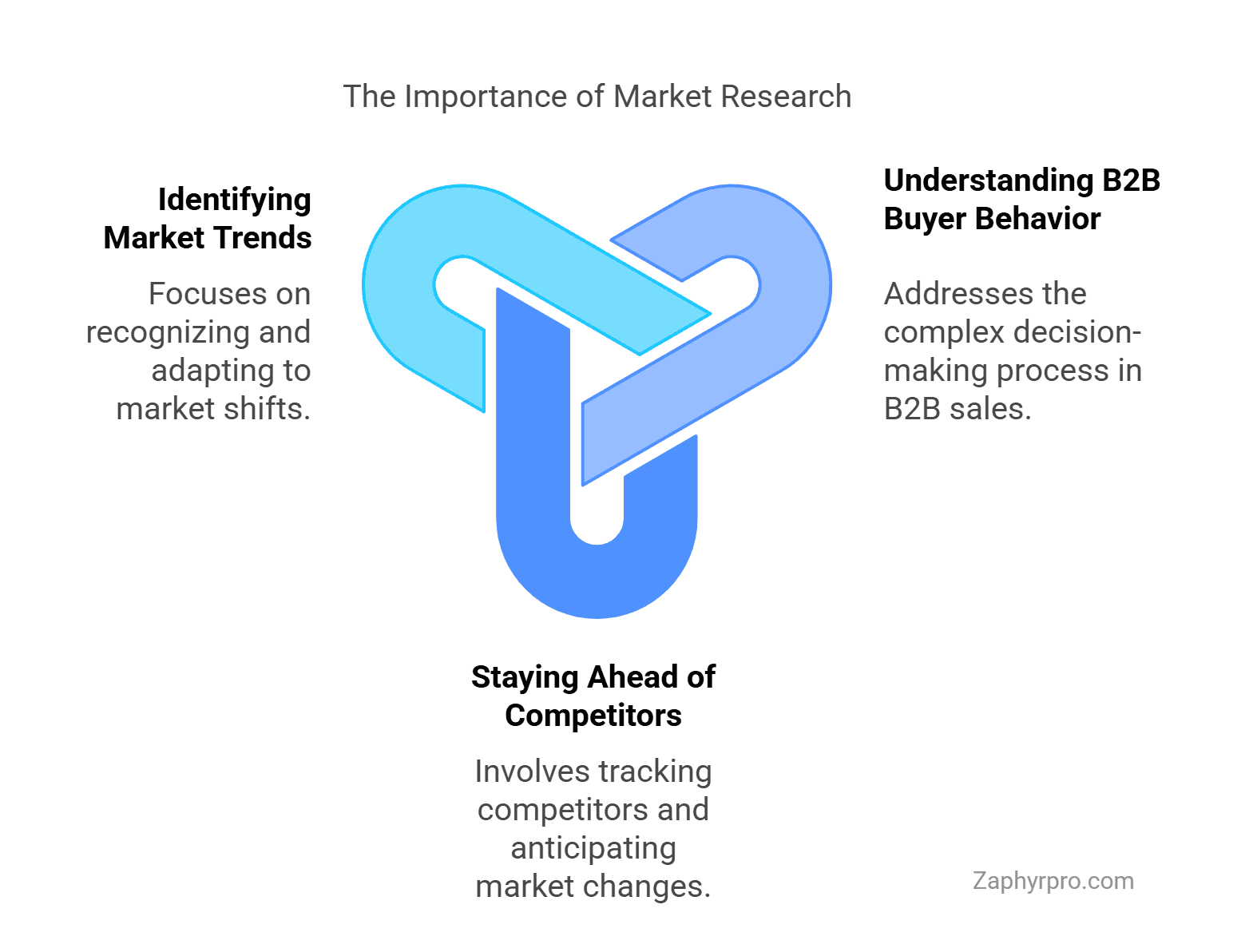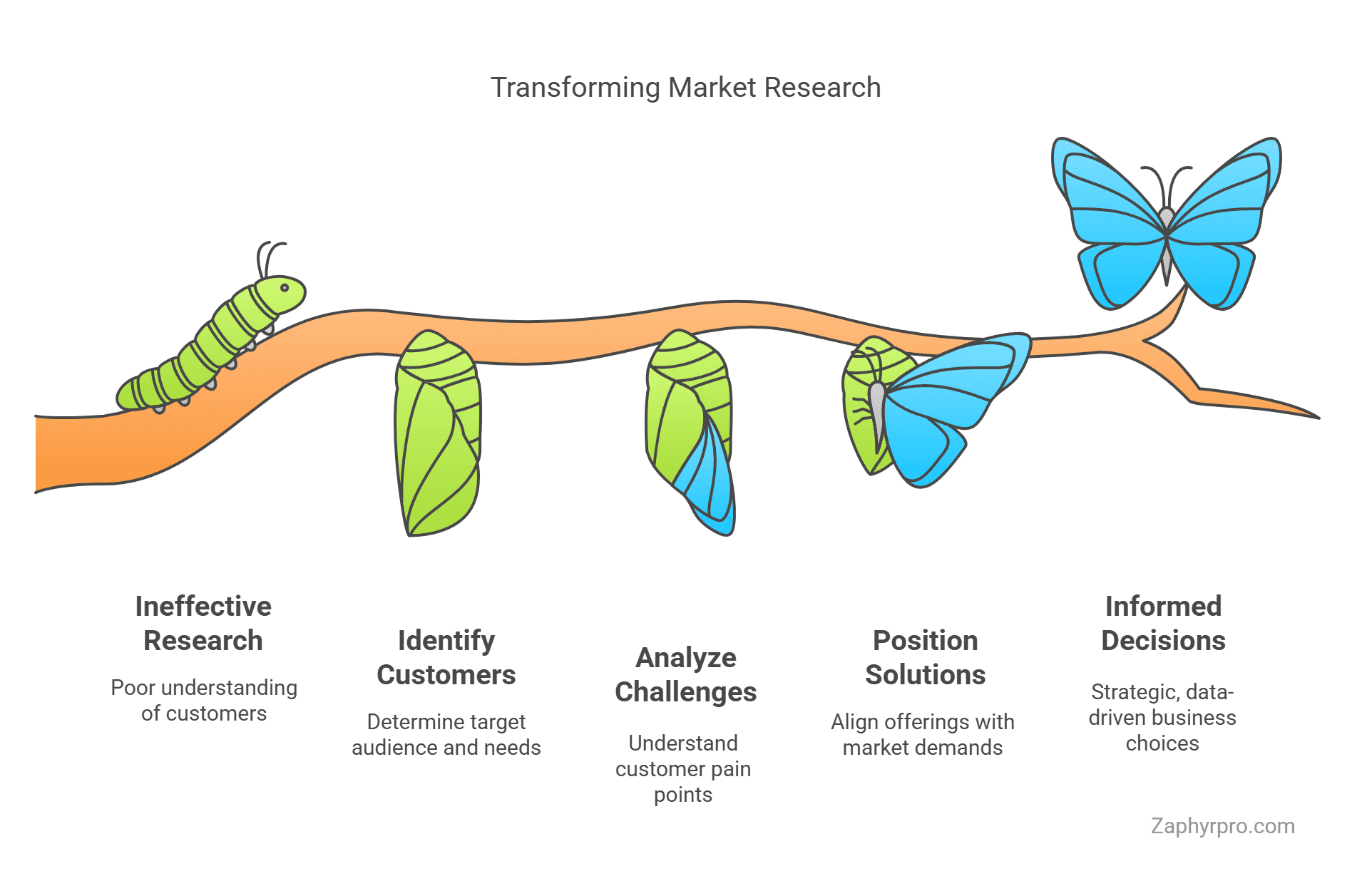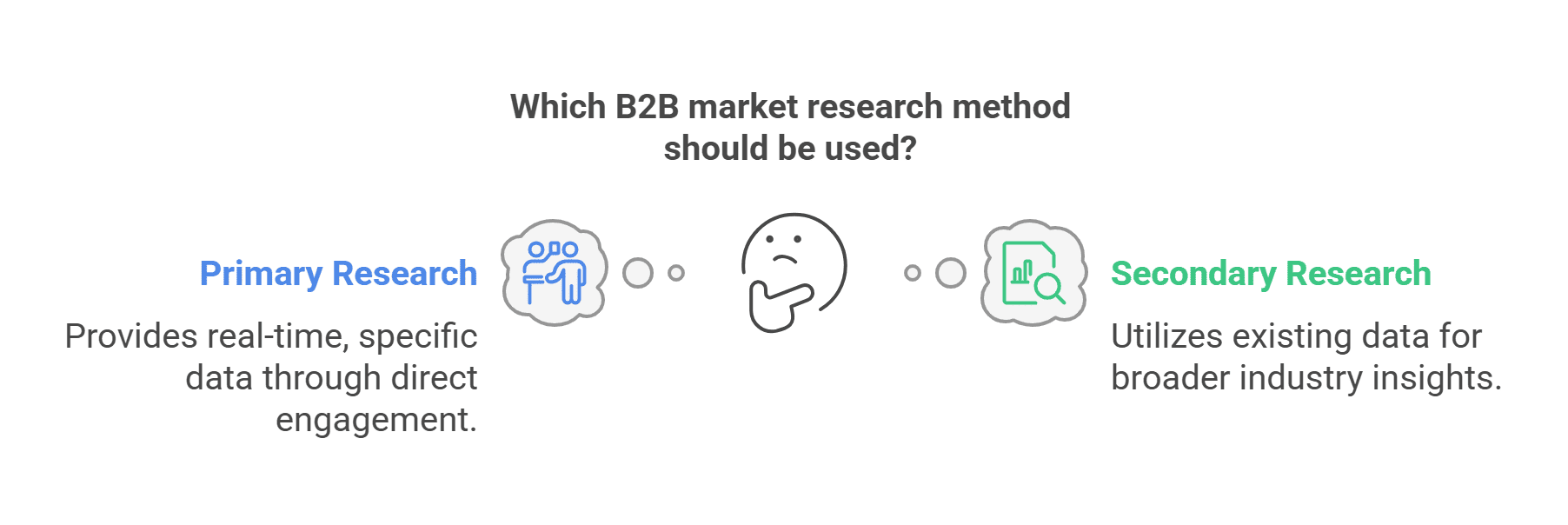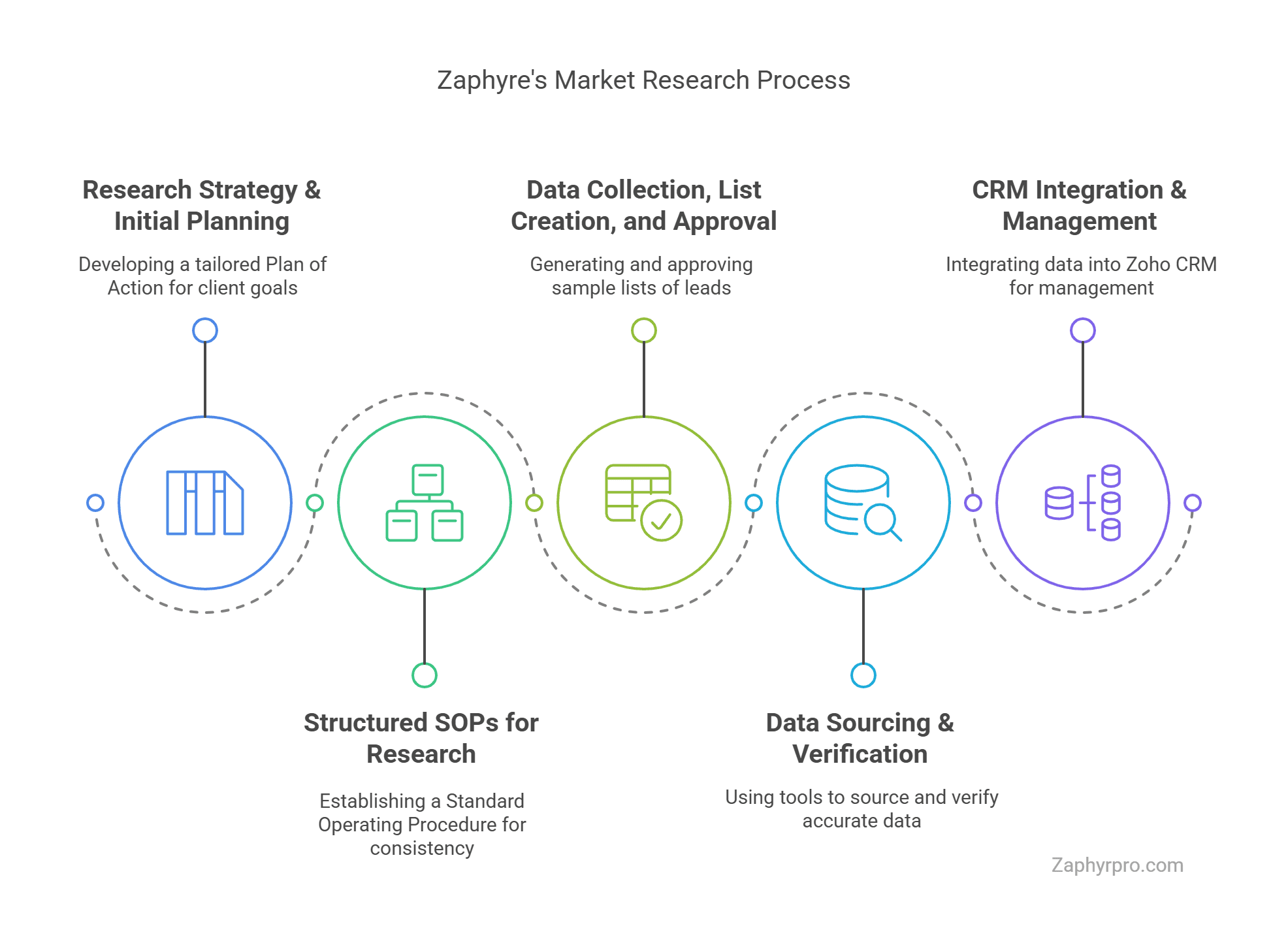Introduction
Market research for B2B companies is essential for driving informed decision-making and shaping business strategies. Unlike B2C markets, where purchases are often driven by emotions and impulse, B2B transactions involve multiple stakeholders, longer sales cycles, and higher-value deals. Without thorough research, businesses risk ineffective marketing, weak sales efforts, and missed opportunities.
By leveraging effective B2B market research tools and structured B2B research methods, companies can gain insights into their target market, customer pain points, and competitive landscape. These insights help businesses craft data-driven marketing strategies, optimize lead generation, and improve customer retention. This blog will explore market research for B2B companies, covering the best B2B market research methods and the best B2B market research tools to streamline the process and drive success.
Understanding Market Research For B2B Companies
Market research for B2B companies is distinct from B2C due to its complexity. B2B buyers conduct extensive research before making purchasing decisions, ensuring products or services align with their business objectives. Unlike B2C, where individual emotions drive buying behavior, B2B purchases are based on logic, necessity, and ROI evaluation.
One of the main challenges of business-to-business market research is navigating multi-level decision-making. Purchasing decisions often involve executives, procurement teams, and department heads, each with unique concerns and priorities. Additionally, B2B sales cycles tend to be longer, requiring consistent nurturing and engagement.
To stay competitive, businesses must use B2B research methods to identify market trends, understand customer pain points, and develop data-backed sales strategies. Conducting online market research, analyzing industry trends, and leveraging customer feedback are critical components of a successful B2B strategy.
B2B Market Research Methods
Primary Research Methods
Primary research involves collecting firsthand data directly from B2B buyers. This method offers valuable insights into customer preferences, industry challenges, and unmet needs.
Surveys and Questionnaires
Surveys provide structured responses from decision-makers, allowing businesses to identify emerging trends and customer expectations. Platforms like Typeform and SurveyMonkey enable companies to create and distribute surveys efficiently.
Interviews and Focus Groups
Interviews provide in-depth qualitative data that helps businesses understand B2B buyers on a deeper level. Conducting one-on-one interviews with industry experts and potential clients offers insights into their needs, motivations, and pain points. Organizing focus groups allows for collaborative discussions that uncover shared industry concerns.
Customer Feedback
Continuous engagement with existing customers ensures businesses stay attuned to evolving market demands. Using Net Promoter Scores (NPS) and advisory panels provides valuable feedback on customer satisfaction, helping businesses refine products and services.
Secondary Research Methods
Secondary research focuses on analyzing existing data sources to extract insights into competitors, industry trends, and market opportunities.
Competitor Analysis
Studying competitors’ marketing strategies, pricing models, and customer engagement methods helps businesses identify gaps in their offerings. Tools like SEMrush and LinkedIn provide data on competitor activities, enabling companies to refine their strategies.
Industry Reports and Whitepapers
Industry leaders like Forrester and Gartner publish valuable reports detailing market shifts, technological advancements, and business challenges. Leveraging these reports allows businesses to anticipate trends and stay ahead of the competition.
Public Databases and Listings
Platforms like Crunchbase, Glassdoor, and business financial records offer insights into potential partners, competitors, and industry benchmarks. Analyzing these sources helps businesses make informed expansion and investment decisions.
Intent-Based and Behavioral Research
Intent-based and behavioral research focuses on analyzing real-time customer interactions, digital behaviors, and engagement patterns to anticipate needs and tailor strategies. By monitoring how prospects interact with content, platforms, and competitors, businesses can align their outreach with buyer readiness, improve personalization, and prioritize high-potential leads. This approach bridges the gap between passive data collection and proactive decision-making, enabling companies to act on signals that indicate purchase intent.
Buyer Intent Data
Predicting customer behavior is critical to identifying high-value prospects. Tools like 6sense analyze digital footprints, engagement history, and search activity to determine which businesses are actively seeking solutions.
Website Analytics & Social Media Insights
Tracking engagement through Google Analytics and LinkedIn Insights helps businesses understand how B2B buyers interact with their digital content. Monitoring page visits, session duration, and social media engagement trends enable companies to fine-tune their marketing efforts for better lead generation.
By implementing these B2B market research methods, businesses can optimize targeting, enhance their sales approach, and make data-driven decisions that drive long-term success.
Essential B2B Market Research Tools
Lead Generation & Prospecting Tools
Finding high-quality leads is essential for any B2B company looking to grow its client base. The right tools help businesses identify and engage with key decision-makers efficiently.
ZoomInfo & Apollo
ZoomInfo and Apollo are among the most effective tools for discovering accurate B2B contact information and detailed company insights. These platforms allow businesses to filter prospects based on industry, company size, job titles, and more. With regularly updated databases, companies can connect with the right leads and improve outreach success rates.
LinkedIn Sales Navigator & PhantomBuster
LinkedIn Sales Navigator provides businesses with advanced search capabilities to find and engage with high-potential prospects. It offers customized lead recommendations and real-time updates on target accounts. PhantomBuster automates data extraction from LinkedIn, enabling businesses to scale prospecting efforts efficiently while maintaining personalized outreach.
More Tools:
- Hunter.io: Extracts email addresses from company websites or LinkedIn profiles, streamlining cold outreach.
- Clearbit: Enriches lead data with firmographic details (e.g., company size, funding) and identifies decision-makers.
- Lusha: Specializes in B2B contact data and direct phone numbers for decision-makers.
- Salesloft or Outreach: Sales engagement platforms that automate follow-ups and track prospect engagement.
- SalesIntel: Combines human-verified contact data with technographic insights and buyer intent signals to scale lead generation.
- Leadfeeder: Tracks website visitors and integrates with CRMs to identify high-intent prospects.
- Emporia Research: Recruits B2B professionals via LinkedIn targeting for surveys and interviews.
- Wynter: Specializes in rapid message testing with B2B focus groups, delivering insights in 48 hours.
- Dynata: Accesses a global panel of 70M+ consumers and businesses for custom surveys and audience insights.
Competitive Intelligence Tools
Competitive intelligence tools help businesses stay ahead by understanding market trends and competitor strategies. Accessing real-time insights enables data-driven decision-making.
6sense
6sense leverages AI-powered intent data to track buyer signals, providing businesses with insights into which companies are actively researching their solutions. This helps sales and marketing teams prioritize outreach to prospects with high purchase intent, increasing conversion rates.
Glassdoor & GetKola
Glassdoor and GetKola offer valuable insights into company culture, hiring trends, and employee reviews. By analyzing competitors’ workplace environments and hiring activities, businesses can refine their recruitment strategies and better position themselves within the industry.
More Tools:
- Crayon: Monitors competitors’ pricing, website changes, and marketing collateral in real time.
- G2 or Capterra: Reveals competitor product reviews, ratings, and customer sentiment.
- SimilarWeb: Provides insights into competitors’ website traffic sources, audience demographics, and engagement metrics.
- SEMrush: Analyzes competitors’ SEO, PPC, and content strategies, revealing keyword gaps and traffic trends.
- Ahrefs: Tracks backlinks, keyword rankings, and content performance to benchmark against competitors.
- SpyFu: Estimates competitors’ AdWords spend and uncovers their paid keyword strategies.
- CB Insights: Provides market sizing data and trend analysis across industries, including VC and M&A activity.
- Exploding Topics: Identifies emerging trends and startup activity to anticipate market shifts.
CRM & Data Management Tools
Managing and organizing client data efficiently ensures that research insights are actionable and accessible to sales and marketing teams.
Zoho CRM
Zoho CRM provides businesses with an integrated platform to store, manage, and analyze customer interactions. It enables lead tracking, automated workflows, and sales forecasting, streamlining operations and improving customer relationships.
Google Sheets & Airtable
Google Sheets and Airtable are excellent for structuring and organizing research data. They allow teams to collaborate in real-time, ensuring that prospect lists, market research findings, and customer insights remain up-to-date and easily accessible.
More Tools:
- HubSpot CRM: Offers free lead tracking, email automation, and analytics for small businesses.
- Scalepath: Streamlines market sizing with AI-driven TAM (Total Addressable Market) models and data integration.
- NewtonX: Uses AI to source global experts for custom B2B research and data analysis.
- Salesforce: Industry-leading CRM for tracking leads, automating workflows, and forecasting sales pipelines.
- Pipedrive: Focuses on visual sales pipelines and activity-based selling.
- Clearbit Enrichment: Automatically appends missing company/contact data to CRM entries.
Data Verification Tools
Ensuring data accuracy is crucial for maintaining high email deliverability and successful outreach campaigns.
ZeroBounce
ZeroBounce is a leading email verification tool that helps businesses maintain high-quality email lists by detecting invalid, outdated, and risky email addresses. By verifying contacts before outreach, businesses can reduce bounce rates, protect the sender’s reputation, and improve engagement with prospects.
More Tools:
- Debounce: Offers real-time email verification API for forms and lead capture.
Utilizing the right B2B market research tools enables companies to refine their strategies, streamline prospecting, and enhance decision-making, ultimately leading to improved sales performance and business growth.
How Zaphyre Conducts Market Research For B2B Companies
Research Strategy & Initial Planning
Zaphyre begins market research by developing a Plan of Action (POA) tailored to each client’s business goals. This involves a detailed competitor analysis to understand industry benchmarks, market gaps, and customer demands. By aligning research efforts with a client’s strategic objectives, Zaphyre ensures that the findings are relevant and actionable.
The Market Research Directions phase further refines the process by outlining key areas of investigation, target audience segmentation, and the selection of appropriate research methodologies. This strategic planning step ensures efficiency and precision, allowing Zaphyre to collect data that directly impacts business decisions.
Structured SOPs for Research
To maintain consistency and quality in research, Zaphyre has a well-defined Standard Operating Procedure (SOP). Clients begin the process by completing an Intake Document, which captures essential information such as target industries, ideal customer profiles, and key research objectives. This document serves as a foundation for the research plan, ensuring alignment with business needs.
The SOP framework streamlines data collection, verification, and analysis. By standardizing research workflows, Zaphyre ensures accuracy, repeatability, and efficiency. This structured approach enables businesses to gain reliable insights into their markets, making data-driven decisions that enhance growth and competitiveness.
Data Collection, List Creation, and Approval
Once the research framework is set, Zaphyre generates sample lists of potential leads and market data. These lists are created using precise filtering criteria based on company size, industry, geographic location, and prospect roles.
Before proceeding with full-scale research, the client reviews and approves the sample list. This ensures that Zaphyre’s data collection aligns with the client’s expectations and target market specifications, refining the research approach if necessary.
Data Sourcing & Verification
Zaphyre utilizes leading B2B market research tools like ZoomInfo and Apollo to extract accurate, up-to-date company and contact data. These platforms enable the identification of decision-makers and provide verified company information, making outreach more efficient.
To enhance data quality, Zaphyre cross-verifies contact details using LinkedIn, Sales Navigator, and ZeroBounce. LinkedIn provides real-time updates on prospects, while ZeroBounce ensures email deliverability by identifying invalid or outdated email addresses. This rigorous data validation process guarantees that clients receive only high-quality, actionable leads that increase the success rate of their outreach campaigns.
CRM Integration & Management
All researched data is seamlessly integrated into Zoho CRM, allowing for organized tracking and efficient management of client lists. By structuring market research data within a CRM system, Zaphyre ensures easy access, segmentation, and follow-up for sales and marketing teams.
This centralized data management approach not only improves workflow efficiency but also enhances collaboration across departments. With well-maintained records and real-time updates, clients can leverage research insights to refine their strategies, optimize engagement, and drive measurable business growth.
Conclusion
Market research is a critical tool for B2B companies looking to optimize sales and marketing efforts. Without data-driven insights, businesses risk ineffective targeting, missed opportunities, and inefficient resource allocation. A well-executed research strategy helps companies understand their market, identify potential leads, and refine their approach to remain competitive.
Using the right B2B market research methods and tools enables businesses to analyze industry trends, track competitor movements, and better understand B2B buyers. This data-driven approach allows for more effective decision-making, improved engagement, and higher conversion rates.
Zaphyre’s structured approach ensures accurate, actionable insights that drive performance and business growth. By leveraging advanced market research techniques, Zaphyre helps companies gain clarity in their sales and marketing efforts, ensuring long-term success.
Ready to enhance your market research strategy? Let’s connect!
Maximize Your Market Research Efficiency with Zaphyre
Unlock data-driven insights that fuel business growth. Zaphyre’s structured market research for B2B companies help you identify high-value prospects, analyze industry trends, and refine your sales strategy with precision. Leverage our expertise to stay ahead of the competition and make smarter business decisions.
Turn insights into action ⇢











